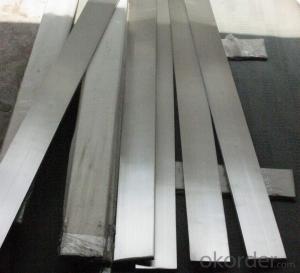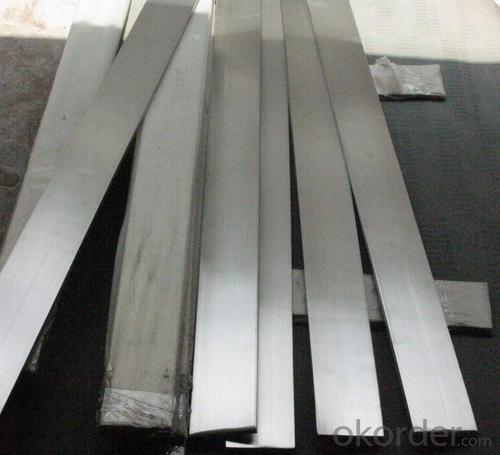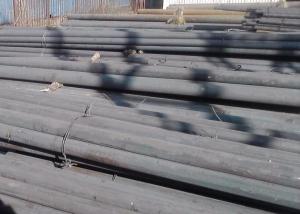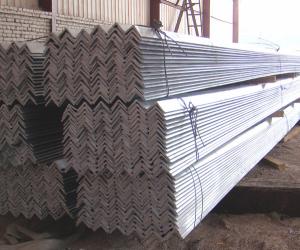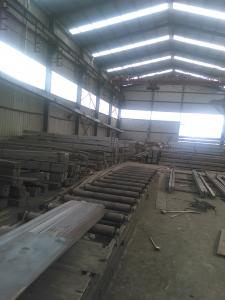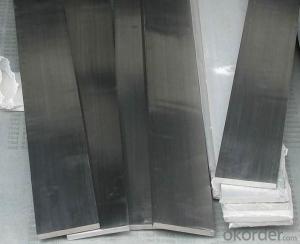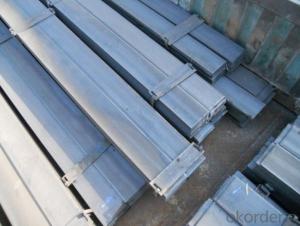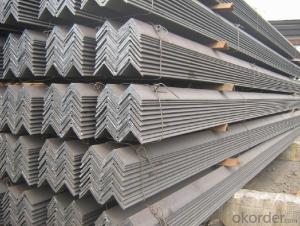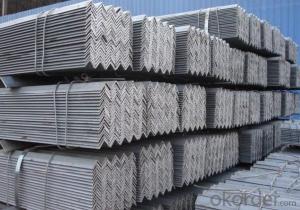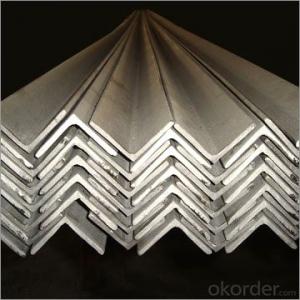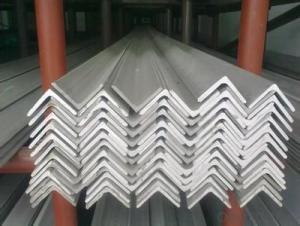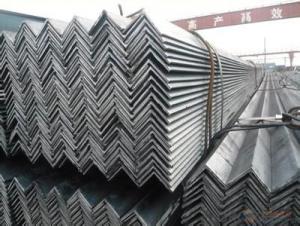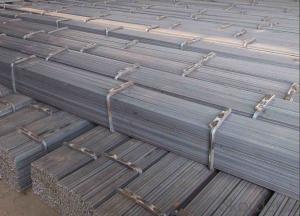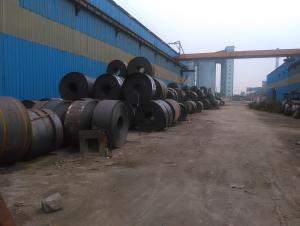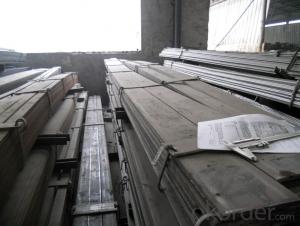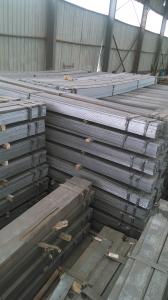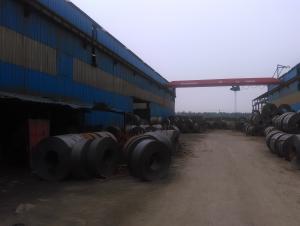Angle Steel Hot Rolled High Quality 25-250MM GB Q235
- Loading Port:
- Shanghai
- Payment Terms:
- TT or LC
- Min Order Qty:
- 25 m.t.
- Supply Capability:
- 200000 m.t./month
OKorder Service Pledge
OKorder Financial Service
You Might Also Like
Product Description:
OKorder is offering Angle Steel Hot Rolled High Quality 25-250MM GB Q235 at great prices with worldwide shipping. Our supplier is a world-class manufacturer of steel, with our products utilized the world over. OKorder annually supplies products to European, North American and Asian markets. We provide quotations within 24 hours of receiving an inquiry and guarantee competitive prices.
Product Applications:
According to the needs of different structures, Angle can compose to different force support component, and also can be the connections between components. It is widely used in various building structures and engineering structures such as roof beams, bridges, transmission towers, hoisting machinery and transport machinery, ships, industrial furnaces, reaction tower, container frame and warehouse etc
Product Advantages:
OKorder's Angle Steel Hot Rolled High Quality 25-250MM GB Q235 are durable, strong, and resist corrosion.
Main Product Features:
· Premium quality
· Prompt delivery & seaworthy packing (30 days after receiving deposit)
· Corrosion resistance
· Can be recycled and reused
· Mill test certification
· Professional Service
· Competitive pricing
Product Specifications:
Manufacture: Hot rolled
Grade: Q195 – 235
Certificates: ISO, SGS, BV, CIQ
Length: 6m – 12m, as per customer request
Packaging: Export packing, nude packing, bundled
Sizes: 25mm-250mm | ||||||||||||
a*t | ||||||||||||
25*2.5-4.0 | 70*6.0-9.0 | 130*9.0-15 | ||||||||||
30*2.5-6.6 | 75*6.0-9.0 | 140*10-14 | ||||||||||
36*3.0-5.0 | 80*5.0-10 | 150*10-20 | ||||||||||
38*2.3-6.0 | 90*7.0-10 | 160*10-16 | ||||||||||
40*3.0-5.0 | 100*6.0-12 | 175*12-15 | ||||||||||
45*4.0-6.0 | 110*8.0-10 | 180*12-18 | ||||||||||
50*4.0-6.0 | 120*6.0-15 | 200*14-25 | ||||||||||
60*4.0-8.0 | 125*8.0-14 | 250*25 | ||||||||||
FAQ:
Q1: Why buy Materials & Equipment from OKorder.com?
A1: All products offered byOKorder.com are carefully selected from China's most reliable manufacturing enterprises. Through its ISO certifications, OKorder.com adheres to the highest standards and a commitment to supply chain safety and customer satisfaction.
Q2: How do we guarantee the quality of our products?
A2: We have established an advanced quality management system which conducts strict quality tests at every step, from raw materials to the final product. At the same time, we provide extensive follow-up service assurances as required.
Q3: How soon can we receive the product after purchase?
A3: Within three days of placing an order, we will begin production. The specific shipping date is dependent upon international and government factors, but is typically 7 to 10 workdays.
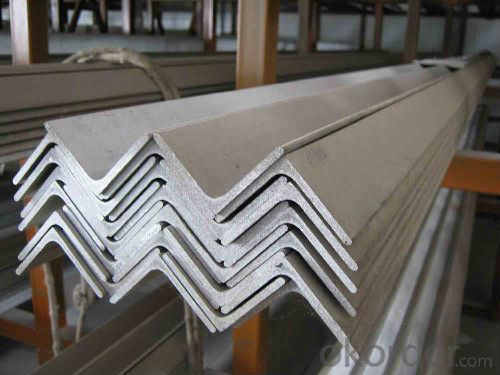
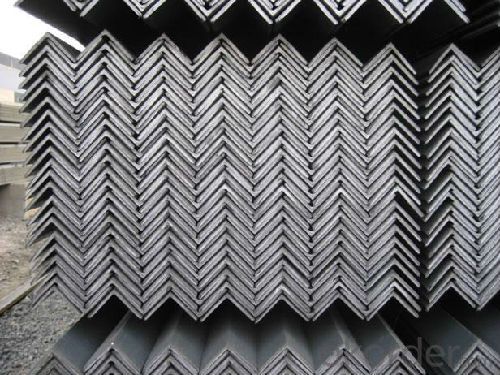
- Q: Can steel flat bars be used in food processing industries?
- No, steel flat bars cannot be used in food processing industries. The reason is that these flat bars are typically made of carbon steel, which can corrode and react with certain food substances. This can lead to contamination of the food and compromise its safety and quality. In food processing industries, it is essential to use materials that are food-grade and have high resistance to corrosion, such as stainless steel. Stainless steel is a preferred choice as it is non-reactive, easy to clean, and has excellent durability. Therefore, it is crucial for food processing industries to prioritize the use of stainless steel flat bars or other food-grade materials to ensure the hygiene and safety of the processed food products.
- Q: Are steel flat bars suitable for making gears or sprockets?
- When it comes to making gears or sprockets, steel flat bars are a truly suitable option, particularly if they are crafted from top-notch steel. Steel possesses exceptional strength, durability, and resistance to wear and tear, rendering it an outstanding material for gears and sprockets that must endure heavy loads and repetitive movements. Furthermore, steel can be easily manipulated and molded into the desired gear or sprocket shapes, making it a versatile choice for such applications. Nevertheless, it is crucial to bear in mind that the specific requirements of the gears or sprockets, including size, tooth profile, and surface finish, must be taken into account when choosing the appropriate steel flat bar for the task at hand.
- Q: Are steel flat bars available in pre-cut lengths?
- Yes, steel flat bars are available in pre-cut lengths.
- Q: How do you store steel flat bars to prevent damage?
- To store steel flat bars and prevent damage, there are a few key steps you can follow: 1. Choose a suitable storage area: Ensure the storage area is clean, dry, and well-ventilated. Avoid storing the flat bars in areas prone to moisture or extreme temperature fluctuations. If possible, designate a specific area for storing steel flat bars to minimize the risk of damage. 2. Use proper stacking techniques: When storing multiple steel flat bars, stack them horizontally on a flat surface. Make sure to align the bars properly, ensuring they are parallel to each other. Avoid stacking them too high to prevent excessive weight and potential bending or warping. 3. Employ appropriate supports: Place timber or rubber supports between the layers of stacked flat bars. These supports prevent direct contact between the bars, reducing the risk of scratches or surface damage. Using supports also helps distribute the weight evenly and maintain the flatness of the bars. 4. Protect against moisture: Moisture can cause rust or corrosion on steel flat bars. To prevent this, consider using moisture-absorbing materials such as silica gel packets or desiccants in the storage area. Additionally, cover the stacked bars with a plastic sheet or tarp to shield them from moisture and humidity. 5. Keep an organized inventory: Maintain a proper record of the stored steel flat bars, including their dimensions, grades, and quantities. Regularly inspect the inventory to identify any signs of damage, rust, or deformation. This will enable you to address any issues promptly and prevent further damage. 6. Handling and transportation precautions: When moving or transporting steel flat bars, use appropriate lifting equipment such as forklifts or cranes to avoid excessive stress on the bars. Always handle them with care and avoid dropping or dragging them, as this can cause dents, scratches, or deformation. By following these guidelines, you can ensure the proper storage of steel flat bars and minimize the risk of damage, preserving their quality and integrity.
- Q: Are steel flat bars suitable for load-bearing shelves or brackets?
- Load-bearing shelves or brackets can be supported by steel flat bars, as they are known for their strength and durability. Steel is an excellent choice due to its ability to withstand heavy loads. The flat shape of these bars provides stability and makes installation easy. Moreover, steel flat bars are resistant to bending and warping, ensuring the shelves or brackets remain sturdy and secure. Furthermore, steel can endure various environmental conditions, making it suitable for both indoor and outdoor use. Consequently, steel flat bars are a dependable and pragmatic option for load-bearing shelves or brackets.
- Q: How do steel flat bars contribute to the strength and stability of structures?
- Steel flat bars play a crucial role in enhancing the strength and stability of structures in multiple ways. To begin with, their flat shape allows for a wide surface area, facilitating the even distribution of loads. Consequently, they can effectively bear heavy weights and resist bending or warping, making them particularly suitable for load-bearing applications like beams, columns, and trusses. Furthermore, the high tensile strength of steel flat bars enables them to withstand significant tension without breaking. This characteristic is of utmost importance in structural design, ensuring their ability to endure forces that pull them apart, such as those arising from earthquakes or strong winds. Moreover, the rigid nature of steel flat bars acts as a deterrent against excessive deflection or movement within structures. By functioning as stiffening elements, they effectively minimize any undesired bending or sagging, thereby enhancing the overall stability of the structure. Additionally, steel flat bars exhibit exceptional durability and corrosion resistance, making them highly suitable for use in diverse environments and weather conditions. This longevity guarantees that structures constructed with steel flat bars will maintain their strength and stability over an extended period. In conclusion, the incorporation of steel flat bars in construction significantly contributes to the strength and stability of structures. Their ability to provide even load distribution, high tensile strength, resistance to deflection, and durability make them a reliable and indispensable component in building structures capable of withstanding various external forces while preserving their integrity for years to come.
- Q: Can steel flat bars be used for making conveyor belts?
- No, steel flat bars are not suitable for making conveyor belts. Conveyor belts require flexible and durable materials that can bend and conform to the shape of the pulleys and rollers while maintaining strength and durability. Steel flat bars are rigid and inflexible, making them unsuitable for this purpose.
- Q: Are steel flat bars suitable for welding or soldering?
- Yes, steel flat bars are suitable for welding or soldering. Steel is a versatile and commonly used material in various industries, including construction, manufacturing, and automotive. Steel flat bars are often used for structural purposes and can be easily welded or soldered together to create larger structures, such as frames or supports. Both welding and soldering methods can effectively join steel flat bars, depending on the specific application and desired strength of the connection. Welding involves melting and fusing the steel together, creating a strong and permanent bond. Soldering, on the other hand, uses a lower temperature to melt a filler material (solder) that flows into the joint, creating a solid connection. However, it is important to note that the specific type of steel used in the flat bars, such as carbon steel or stainless steel, may require different welding or soldering techniques and materials. It is always recommended to consult with a professional or refer to the manufacturer's guidelines for specific instructions on welding or soldering steel flat bars.
- Q: What are the different shapes available in steel flat bars?
- Steel flat bars come in various shapes, each designed to meet specific requirements and applications. Some of the different shapes available in steel flat bars include flat, round-edged, square-edged, and round. 1. Flat shape: This is the most common and basic shape of steel flat bars. It has a rectangular cross-section with two parallel and flat surfaces. Flat bars are widely used in construction, manufacturing, and fabrication industries for structural support, framework, and general applications. 2. Round-edged shape: Steel flat bars with round edges have a slightly curved or rounded profile on the edges. This shape is preferred when the flat bar may come in contact with other materials or people, as it reduces the risk of injuries or damage caused by sharp edges. Round-edged flat bars are commonly used in furniture, automotive, and architectural applications. 3. Square-edged shape: Similar to the flat shape, square-edged steel flat bars have sharp, square corners. This shape is ideal when precise right angles are required or when the flat bar needs to fit into specific slots or joints. Square-edged flat bars are commonly used in construction, machinery, and manufacturing industries. 4. Round shape: While not technically a "flat" bar, steel round bars are widely used in various industries. Round bars have a circular cross-section and are often used for applications that require strength, durability, and resistance to deformation. They are commonly used in construction, engineering, and automotive applications. It is important to note that these are just a few examples of the different shapes available in steel flat bars. Manufacturers may offer custom shapes and profiles to meet specific project requirements.
- Q: What are the advantages of using alloy steel flat bars?
- Alloy steel flat bars possess numerous benefits. Firstly, they are renowned for their exceptional strength and durability. By combining various metals, such as chromium, nickel, and molybdenum, with iron, alloy steel flat bars become significantly stronger and more resistant to wear and tear when compared to ordinary steel. Consequently, they are ideal for industries requiring superior strength and toughness, such as construction, manufacturing, and engineering. Secondly, alloy steel flat bars exhibit remarkable corrosion resistance properties. The inclusion of elements like chromium enhances their ability to withstand rust and corrosion, rendering them suitable for environments with high moisture levels or exposure to chemicals. As a result, the lifespan of these flat bars is considerably prolonged, thereby reducing the need for frequent maintenance or replacements. Moreover, alloy steel flat bars offer versatility in terms of their applications. They can be easily machined, welded, and molded into various shapes and sizes, allowing for customization to specific project requirements. This adaptability renders them suitable for a broad range of uses, including structural supports, machinery components, tools, and automotive parts. Furthermore, the high temperature resistance of alloy steel flat bars provides another advantage. They can endure elevated temperatures without compromising their strength or structural integrity. Consequently, they are well-suited for industries involving high heat, such as aerospace, energy, and power generation. Lastly, alloy steel flat bars offer cost-effectiveness. Although they may entail a higher initial cost compared to regular steel, their durability and longevity make them a cost-effective choice in the long run. Their resistance to wear, corrosion, and deformation minimizes the need for frequent replacements, repairs, and maintenance, ultimately saving both time and money. In conclusion, alloy steel flat bars possess numerous advantages, including high strength, durability, corrosion resistance, versatility, high temperature resistance, and cost-effectiveness. These properties establish them as a dependable and efficient option for a wide range of applications in various industries.
Send your message to us
Angle Steel Hot Rolled High Quality 25-250MM GB Q235
- Loading Port:
- Shanghai
- Payment Terms:
- TT or LC
- Min Order Qty:
- 25 m.t.
- Supply Capability:
- 200000 m.t./month
OKorder Service Pledge
OKorder Financial Service
Similar products
Hot products
Hot Searches
Related keywords
